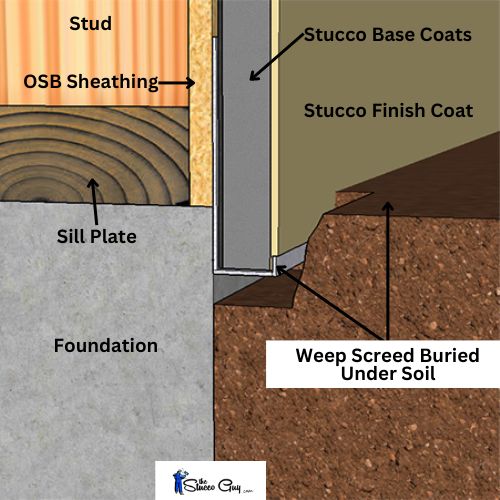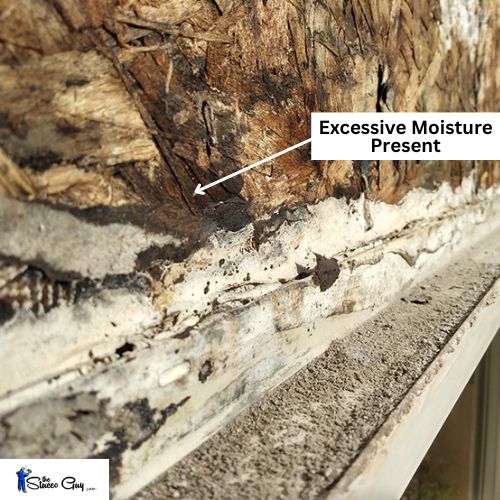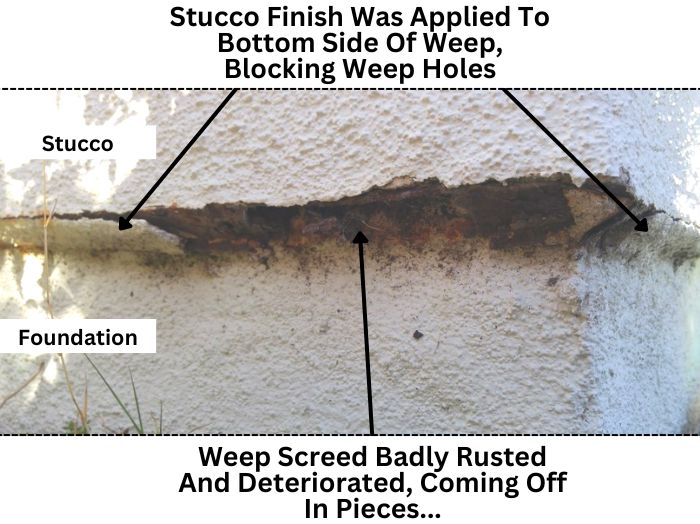Weep screed that is installed along the bottom of your walls can become rusted out over time and many things can cause this. Some issues that cause these rust spots or areas are not that alarming and can be easily fixed, but other issues can sometimes indicate something bigger at play.
Knowing what's causing the rusting is key and can help solve the problem and give you an idea of how much work will be involved to fix the issues.
Weep Screed Overview:
Weep screed is made from 26 gauge (minimum) steel and is supposed to be galvanized to prevent corrosion from forming. There are a few other options out there when it comes to what the metal is made out of, but these are usually a lot more expensive and have to be special ordered, in some cases.
Since rust needs moisture to actually form, then rust on your weep screed means that moisture is getting in or on your weep and causing this problem. Where the moisture is originating from is really the question that needs to be addressed and will usually indicate whether the problem is a small one or a larger issue somewhere higher up in the wall or walls.
What Can Cause The Weep Screed To Rust?
There are many things that can cause the weep screed to rust and can help to pinpoint the root cause of your problem.
Sprinklers: If you have sprinklers that water the landscaping around your home and they come on often, like in the summer, then the excessive amount of water can possibly be hitting the wall and saturating it every time they are turned on.
To verify this, you can watch the where and what the water hits and see if you notice them spraying any of your walls. If this is the cause of your rusted out weep screed, then all you would have to do is adjust the sprinkler(s) so they no longer spray on the stucco walls and replace the weep screed, if necessary.
Buried Weep Screed: If the weep screed is buried beneath soil, concrete or anything else, then water will not be able to exit the stucco assembly as fast as it should be able to and can lead to rusting.
If soil is the only thing covering the weep screed, then simply removing some, so you have a good clearance, is fairly easy to do. If you can't do that, then adding a drain to the perimeter of the walls that allows the excess moisture to drain out and away somewhere else (redirect the water) is your other option.
If your weep is buried beneath concrete, asphalt, pavers or some other material like that, then you will have to remove some of the material, fix any stucco issues that have developed and add a drainage system, in order to properly fix the issue. This will be a more involved process than if you had soil around these areas.

Little To No Overhang From Your Roof: The roof of your home keeps things dry on the inside, but it also protects the outside walls as well. Having a large overhang will provide a lot of protection against moisture and is the best way to protect your stucco walls.
I have seen so many walls that get battered by rain due to the fact that there is little to no overhang protecting them. This large amount of water can affect the weep screed after a period of time, especially if it is a large wall that is located on the side of the building where the storms regularly come from.
There really is no remedy to this, other than an expensive redesign of the roof or an awning of some sort.
Blocked Weep Holes: Blocked weep screed holes can also be a contributor to rusting out these metal flashings because the water has nowhere to go, so it just sits in the weep screed channel and stays there. Even if the holes aren't blocked fully, it could cause the slower drainage rate of the water to do visible damage to the metal itself, via rust.
To fix these issues, you will want to inspect all of the holes in your weep around the entire building and remove the obstructions. If these were covered by the stucco finish, try to scrape it off. If they were caulked, then clear them out and if they were clogged up by soil, then do some digging and grading or install a drainage pipe.
Coating On Metal Has Worn Off: Since the metal is galvanized, it is usually in the form of a coated material and is usually pretty thin. If this coating wears off and water is introduced, it will rust very quickly because it is now just bare steel and there is no corrosion protection left. This will usually be visible as some sort of damage to the metal itself, whether it was smashed or scratched and should be easily identifiable.
Fastener Rusting: Another possibility could be that a nail or staple that was used when installing the wire could be rusting out and dripping down onto the weep screed.
This could only be confirmed by removing some stucco though and most of the time, the discoloration is the only problem associated with this type of situation and not worth breaking out the stucco to fix the problem. Most people would probably not justify the cost unless other issues were present.
Weep Was Rusted Prior To Installation: This is a pretty rare scenario, but is a possibility. If the weep screed that was installed was starting to rust on areas prior to it being installed, then it would continue as time went on and would get worse, especially if moisture was introduced.
This is extremely rare though and not likely in 99% of applications, but was worth mentioning. In fact, it would be tough to even prove that this happened, in most cases.
Excess Moisture In Stucco Assembly: This is probably going to be the "worst case scenario" where water is getting in from somewhere higher up in the wall and running down causing excessive moisture issues and showing itself on the weep screed.
The main culprits for this, in my experience, are usually failed window flashing, many small cracks in the wall, allowing excess moisture in or a failing water resistive barrier (a.k.a. the paper underneath).
This will usually be harder and more costly to diagnose, as the stucco would have to be removed to find the root cause of the problem. This would be a "last resort" type of thing though, as it would be a major fix.

Do I Need To Replace Rusty Weep Screed?
Now that you can visually see that your weep is rusted and you have found the cause, you will likely be in the spot of whether to replace the bad section(s).
The answer to that question will depend on a few different things. How many sections of weep are affected and the length of affected areas, whether it is more of a cosmetic or functionality type of problem and whether you have the time and/or money to fix the problem.
If you have one or two small sections of weep screed that is rusted, then it might not be worth replacing it, as it most likely will not cause many issues. If you can't stand the way it looks, then you might want to replace that section of weep screed, to stop the problem, as long as it is localized to that area.
Get Someone Out To Take A Look: It is really hard to diagnose whether you need to replace the weep, as there are many different variables involved and getting a contractor out to check it out can be the easiest way to go about it. You could even pay them for their time to get a more thorough evaluation and even have them remove some of the stucco above the affected areas to see what they find.


